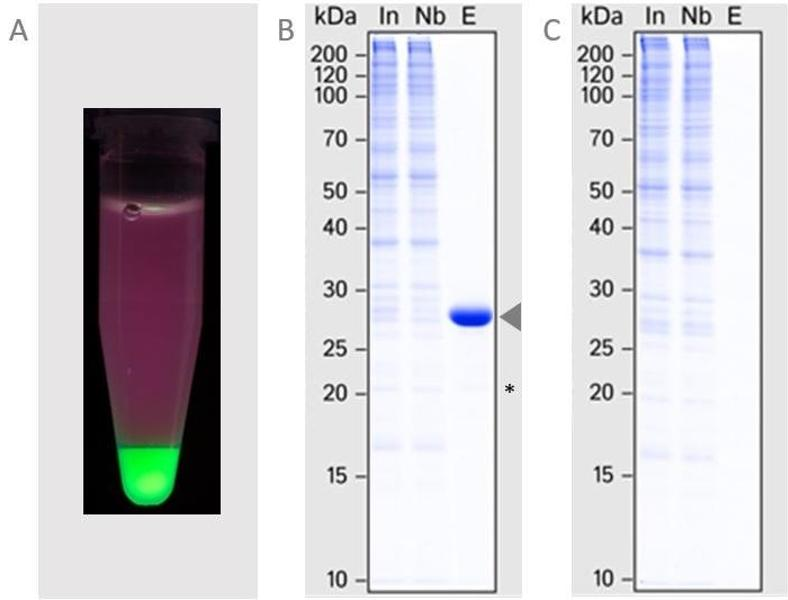GFP Catcher - High-Affinity Single-Domain Antibodies
Written/ Edited by Julian Pampel, BScantibodies-online offers GFP catchers, the ideal tool for effective pulldown of GFP fusion proteins. Our catcher product lines are based on recombinant single-domain antibodies (sdAbs) derived from llamas or alpacas. This type of affinity molecules provide significant advantages over conventional IgG molecules. All of our products are produced in-house. They are highly specific with affinities tailored for a wide range of applications.
What are GFP Catchers?
The GFP Catcher is a ready to use affinity resin for immunoprecipitation of GFP-fusion proteins. GFP-Catchers and Catchers in general are based on a high-affinity single-domain antibody (sdAb) that is covalently immobilized on 4 % cross-linked agarose beads. The GFP-Catcher (ABIN5311508) thus features high affinity and superior capacity for GFP fusion proteins while showing negligible non-specific background (Fig.1). Due to the covalent and stable linkage of an GFP-specific sdAb to the agarose support, bound GFP fusion proteins are eluted from GFP Selector without contaminating IgG chains (* Band originating from maturation of GFP). GFP-Catchers immobilize a wide range of GFP derivatives: EGFP, mEGFP, Sirius, tSapphire, Cerulean, eCFP, mTurquoise, acGFP, Emerald, superecliptic pH luorin, paGFP, superfolder GFP, eYFP, mVenus and Citrine and most common CFP and YFP variants are being recognized. GFP-Catchers are compatible not only with physiological buffers but also with high stringency buffers. GFP-Catchers thus provide great freedom to adjust the binding and washing conditions to the experimental needs. In comparison with competitor products, our antibodies-online GFP Catcher (ABIN5311508) offers an increased binding capacity, 1 µl of packed beads is able to bin 4 μg GFP.
GFP Catcher ABIN5311508

Fig.1: (A) Pull-down of GFP from a mixture of GFP, mCherry and mTagBFP (B) Immunoprecipitation of GFP (arrow) from HeLa lysate. (C) Control experiment using functionalized beads lacking sdAbs.
Advantages of Catchers for IP
The Agarose beads of our catchers offer, in comparison with magnetic beads, the lowest background and high binding capacity for IP. The innovative, oriented and selective attachment via a flexible linker guarantees a high accessibility of the sdAbs and largely eliminates batch-to-batch variations. Due to the single-chain nature of sdAbs and their covalent attachment, no "leakage" of light and heavy chains from IgGs is observed during elution with SDS sample buffer. The absence of heavy & light antibody chains enables to drastically decrease the incubation time to 5-30 minutes. Even under harsh conditions the antibody binds with very high affinity and pulls out even low abundant proteins.
All Catchers at one glance
Need Help? Call our PhD Customer Support!
- We help you with finding the right product for your research.
- We offer Catchers as reliable replacement for Traps in IP experiments
- Contact us via email or phone: (877) 302 8632 (US) or +49 241 95 163 153 (International)
Catcher Applications
All catcher agarose beads are validated and tested for a variety of applications:
- Protein Complex Immunoprecipitation (Co-IP)
- Immunoprecipitation (IP)
- Purification (Purif)
- Chromatin Immunoprecipitation (ChIP)
- RNA-Binding Protein Immunoprecipitation (RIP)
Additive Products
Catcher-Control is a control resin for all Catcher resins, which are based on 4 % cross-linked agarose beads. It was prepared using the same activation and quenching chemistry that was used for preparation of Catcher resins, but is not charged with any single-domain antibody. Catcher-Control is thus the ideal resin for pre-depletion of extracts or as a side-by-side specificity control for any Catcher resins. When using as a specificity control, Catcher-Control and the corresponding sdAb-charged Catcher Resin should be used under identical experimental conditions.
Protocols

Creative mind of antibodies-online with a keen eye for details. Proficient in the field of life-science with a passion for plant biotechnology and clinical study design. Responsible for illustrated and written content at antibodies-online as well as supervision of the antibodies-online scholarship program.
Go to author page



